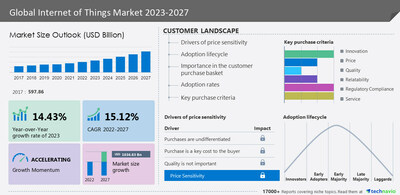Source prnewswire
Internet Of Things Market size is set to grow by USD 1,036.83 billion from 2022-2027, The increasing industrial automation to drive the market growth, Technavio
The internet of things market size is estimated to increase by USD 1,036.83 billion from 2022 to 2027, according to Technavio. The market is estimated to grow at a CAGR of almost 15.12% during the forecast period. The rise in market growth is primarily fueled by the increased adoption of industrial automation. Industries are undergoing a profound shift, embracing both digital and physical systems, facilitating seamless machine-to-machine (M2M) communication and enhancing human-machine interfaces (HMI). Developed regions are at the forefront of this transformation, epitomizing Industry 4.0, wherein intelligent machines drive manufacturing operations, robots collaborate alongside humans in production, and autonomous transport vehicles manage logistics. The convergence of physical and digital realms in industrial manufacturing amplifies efficiency, predictive maintenance capabilities, safety standards, and overall profitability. This widespread embrace of Industry 4.0 principles on a global scale is optimizing material flows and revolutionizing error detection across product lifecycles. Pioneering initiatives such as Germany's Industrie 4.0 program and the Smart Manufacturing Leadership Coalition (SMLC) in the United States are dedicated to setting universal standards and fostering intelligent factory ecosystems. Consequently, the escalating automation of Industry 4.0 processes is poised to fuel the demand for IoT solutions in the foreseeable future0 processes is poised to fuel the demand for IoT solutions in the foreseeable future For more insights on the historic (2017 to 2021) and forecast market size (2023 to 2027) – Buy the full report Segment OverviewTechnavio has segmented the market based on Application (Industrial, Retail, Healthcare, ICT, and Others), Technology (RFID, Sensors, NFC, Cloud services, and Others), and Geography (APAC, North America, Europe, Middle East and Africa, and South America). Geography OverviewBy geography, the global Internet of Things market is segmented into APAC, North America, Europe, Middle East and Africa, and South America. The report provides actionable insights and estimates the contribution of all regions to the growth of the global Internet of Things market.Leading trends influencing the market Major challenges hindering the market growthAnalyst ReviewThe advent of 5G technology has catalyzed the proliferation of the Internet of Things (IoT) ecosystem, revolutionizing the way devices communicate and interact. In this burgeoning landscape, various IoT vendors are vying for market dominance across a myriad of industry verticals, from healthcare to transportation. At the heart of this interconnected web lie Radio Frequency Identification (RFID) tags, enabling seamless data exchange and tracking capabilities. IoT hinges on robust communication technology infrastructures, facilitating the seamless flow of information between connected devices. This is particularly significant in developing economies, where improved internet connectivity has the potential to spur economic growth and societal development.Transformation Consumer behavior is undergoing a paradigm shift, as IoT-enabled experiences reshape interactions with retail outlets. Real-time insights gleaned from sensor-driven decision analytics empower retailers with unprecedented marketing analysis capabilities, facilitating personalized engagements and enhancing customer satisfaction.Beyond retail, IoT permeates diverse sectors including the energy, healthcare, and transportation industries. In the healthcare sector, IoT facilitates remote patient monitoring and enhances operational efficiencies. Similarly, in the transportation sector, IoT powers smart cities initiatives, optimizing traffic flow and enabling smart transportation systems.While 4G networks laid the groundwork for IoT proliferation, the emergence of NB-IoT networks promises enhanced scalability and efficiency. These networks underpin a multitude of IoT applications, from smart parking solutions to environment monitoring initiatives aimed at fostering sustainability.






No Comments